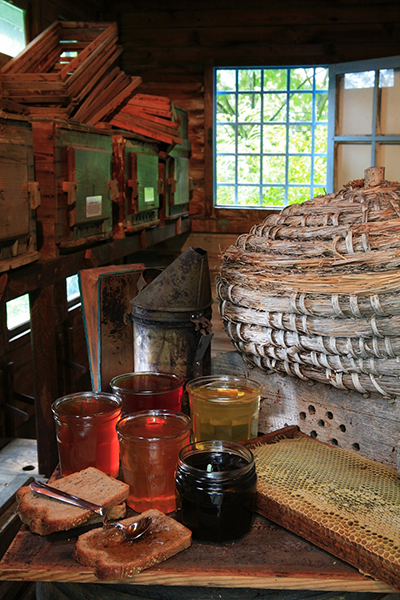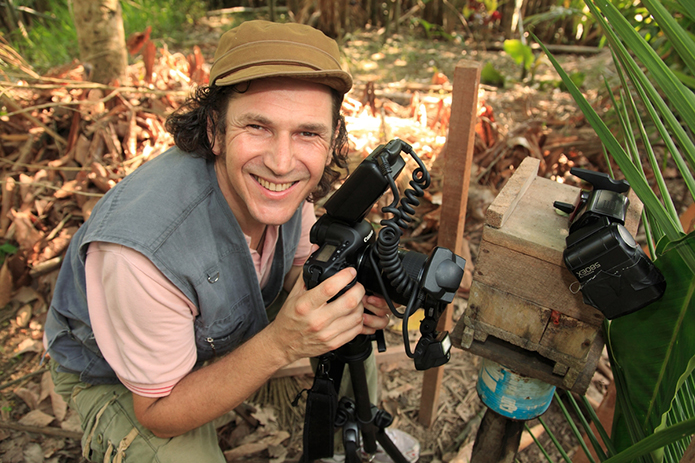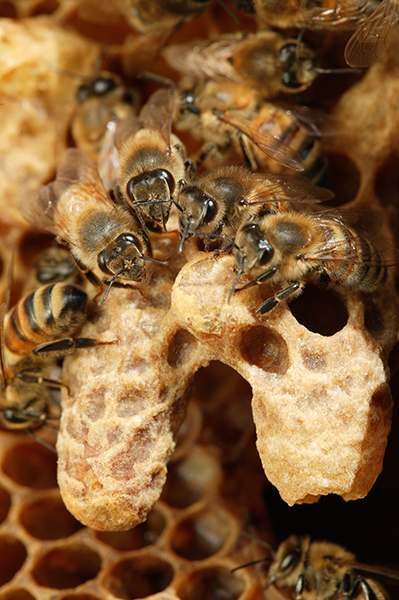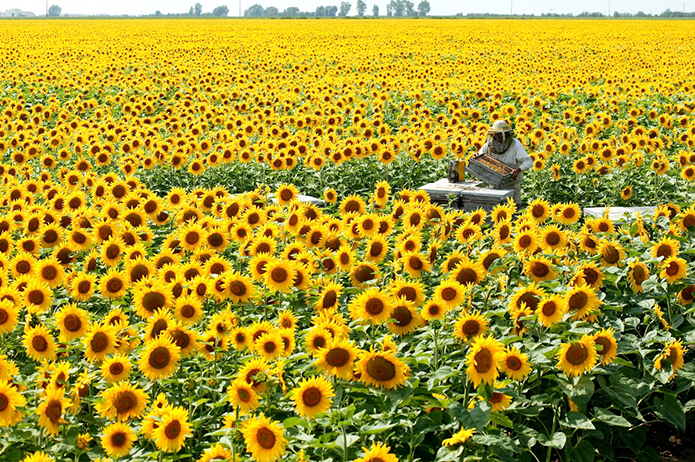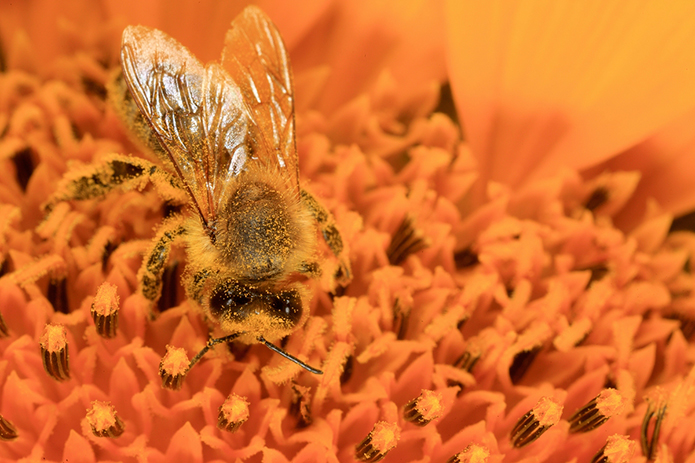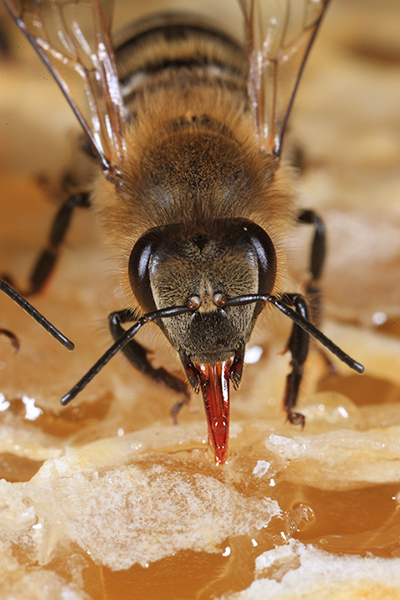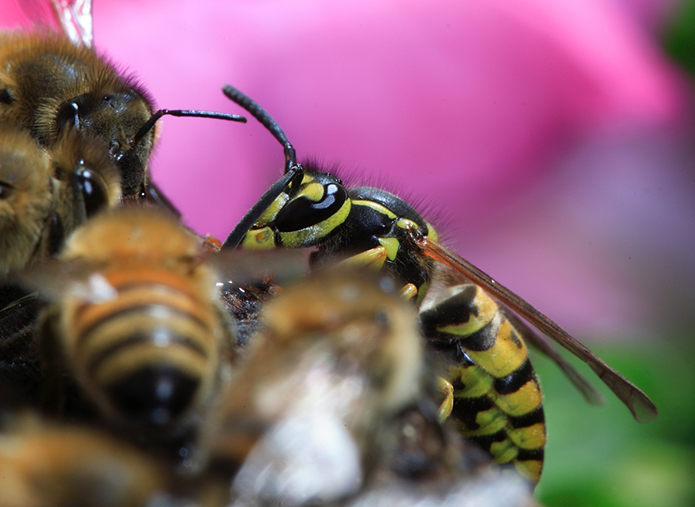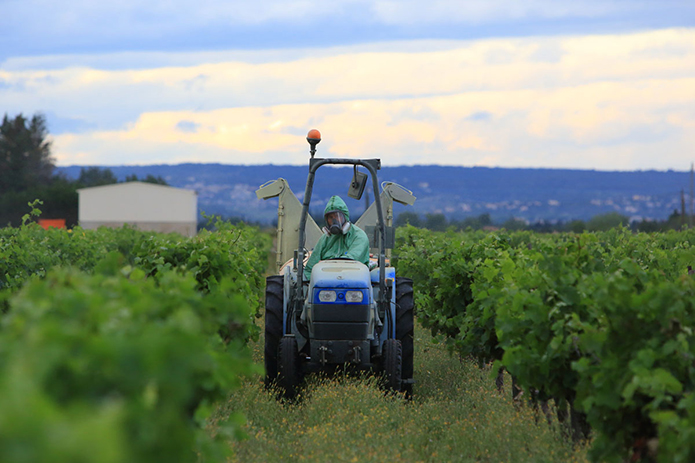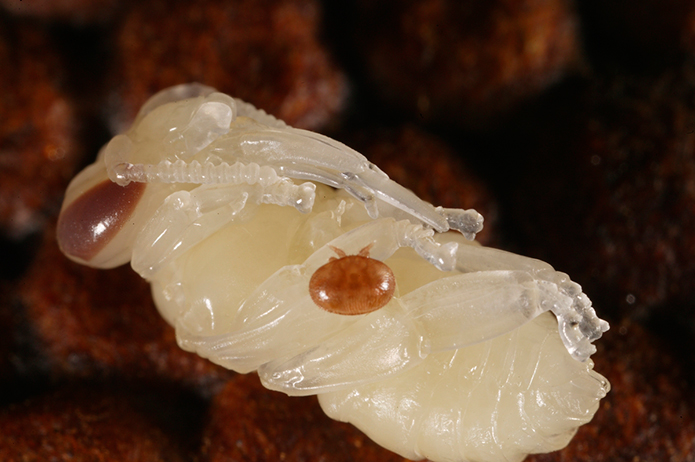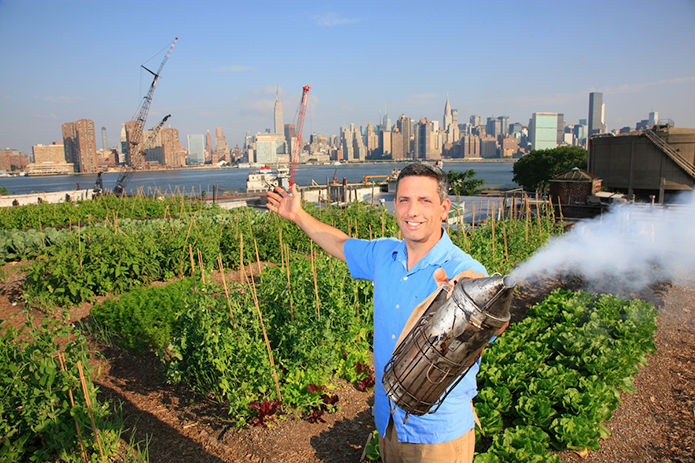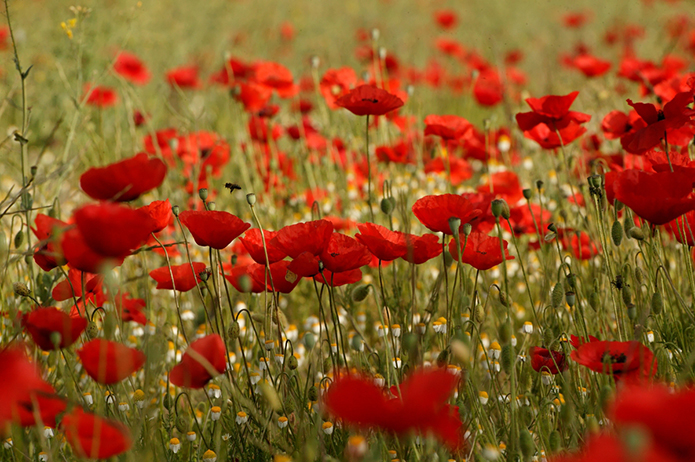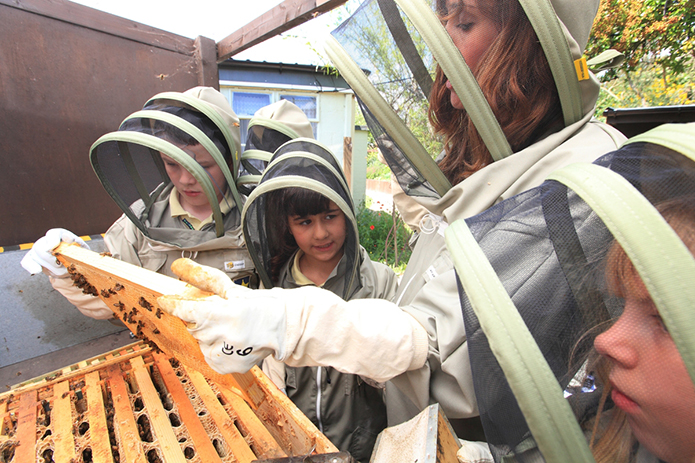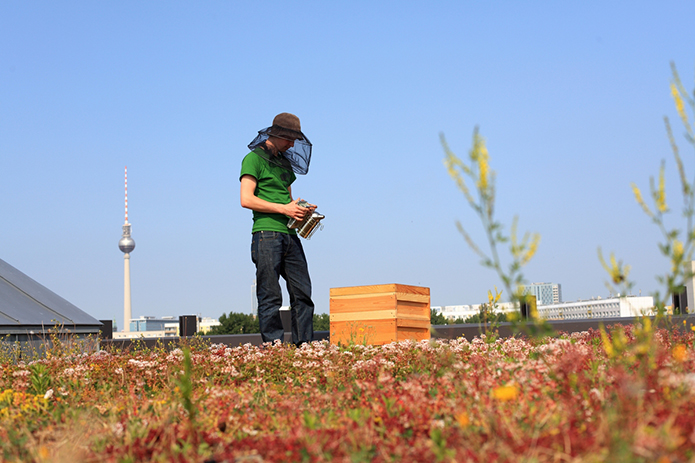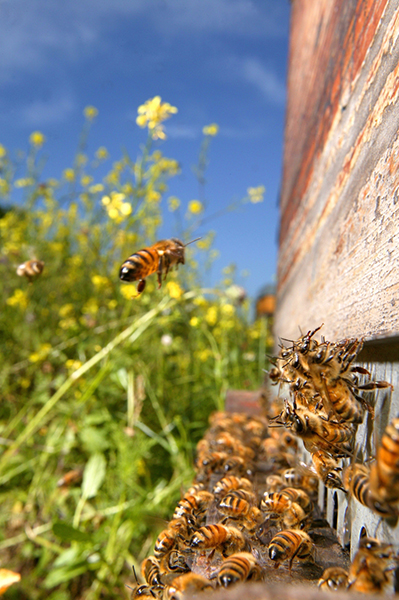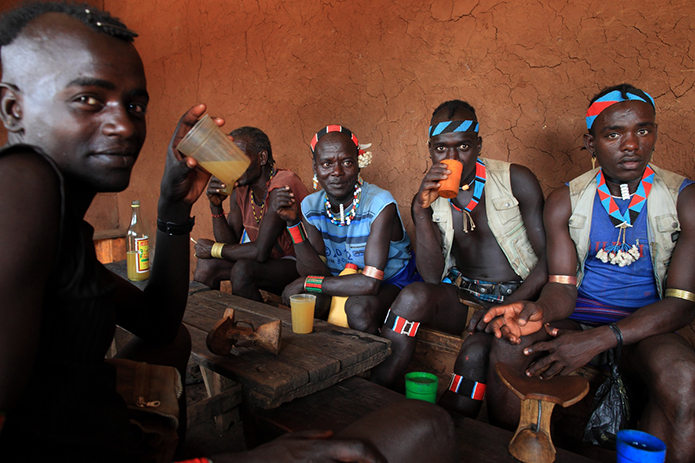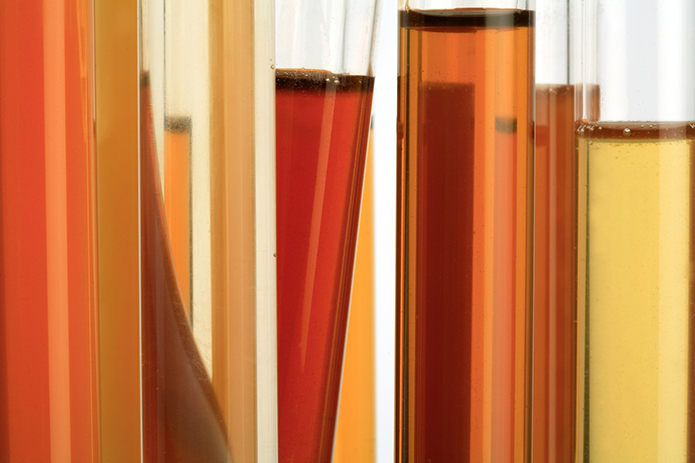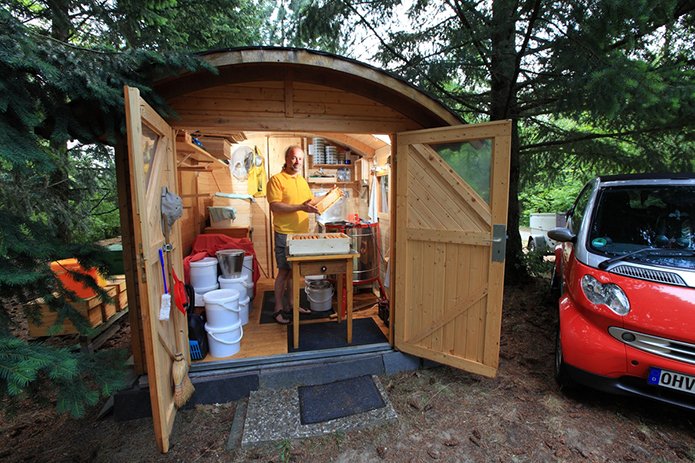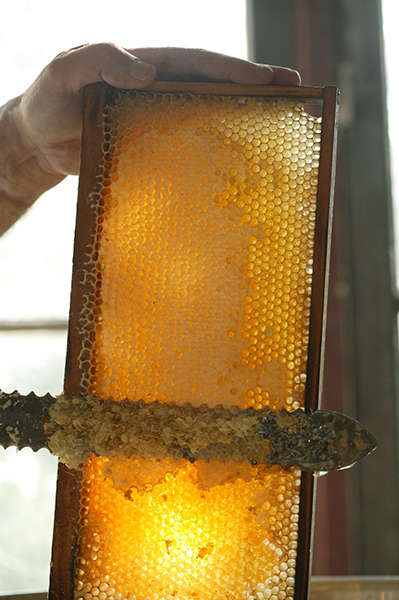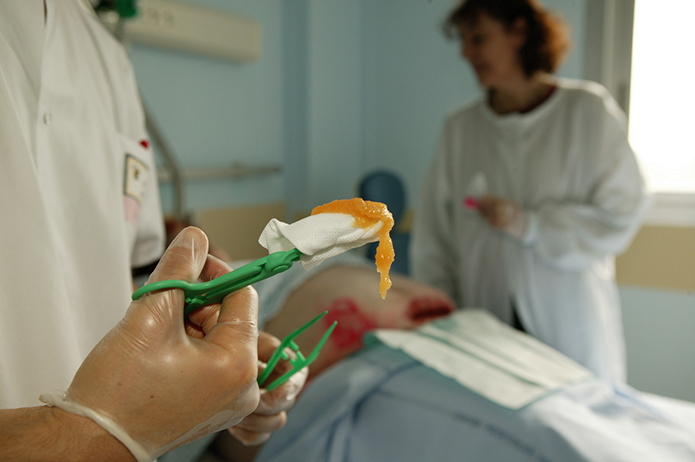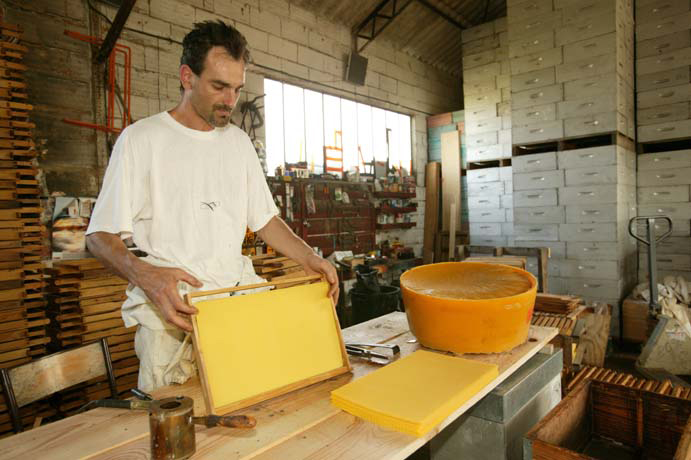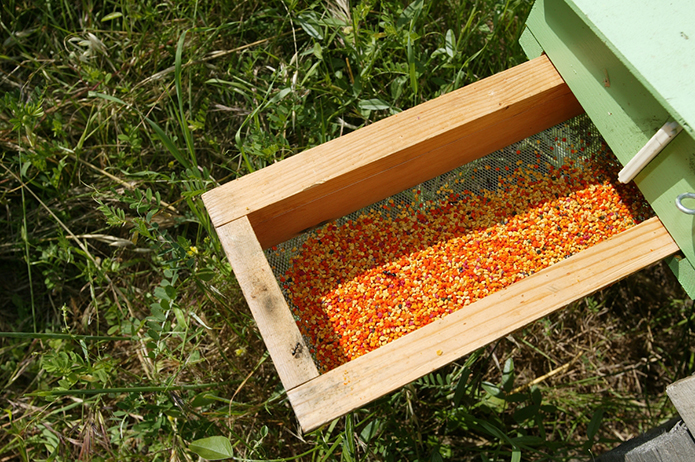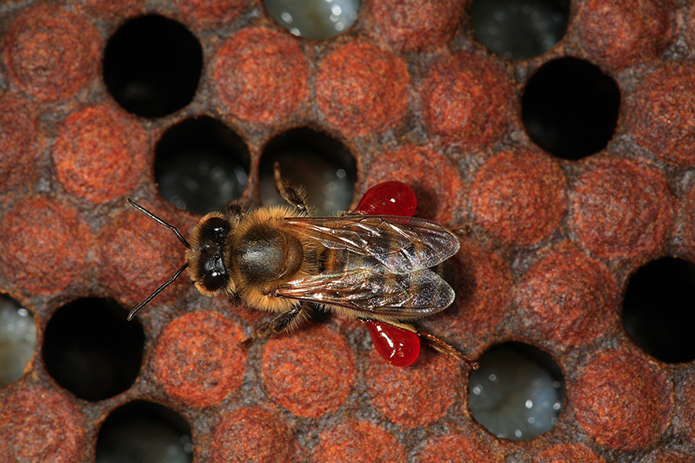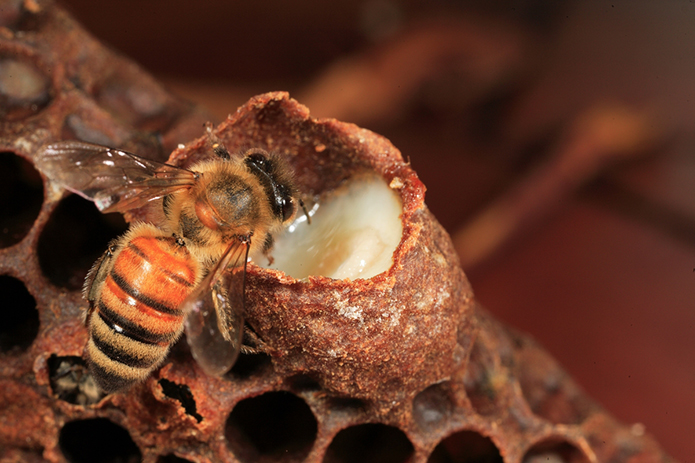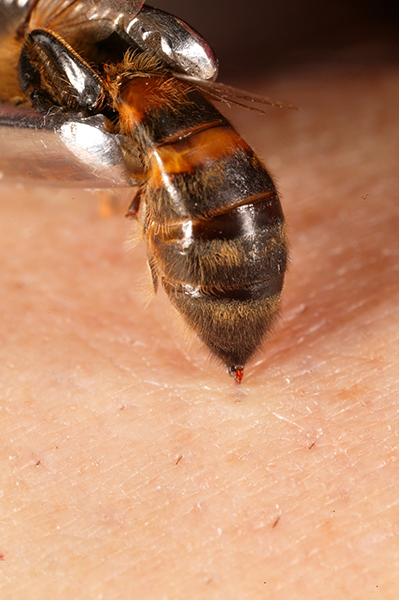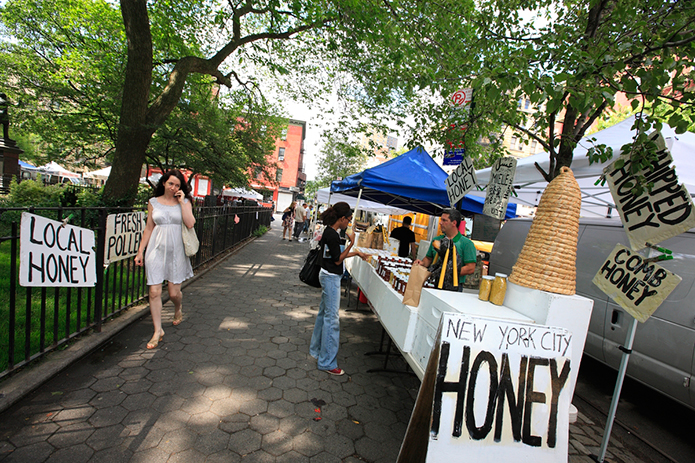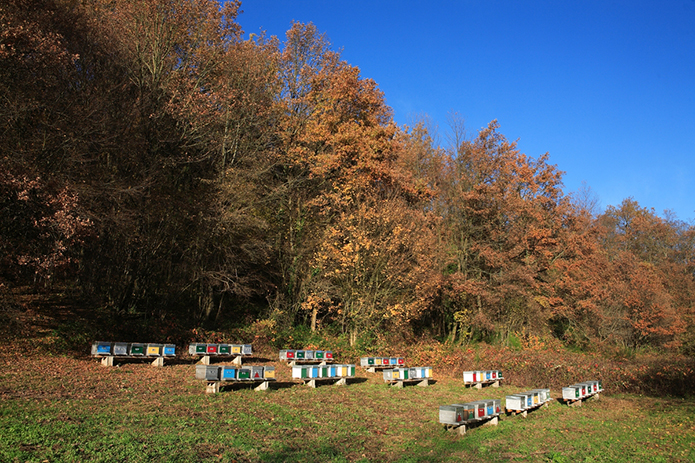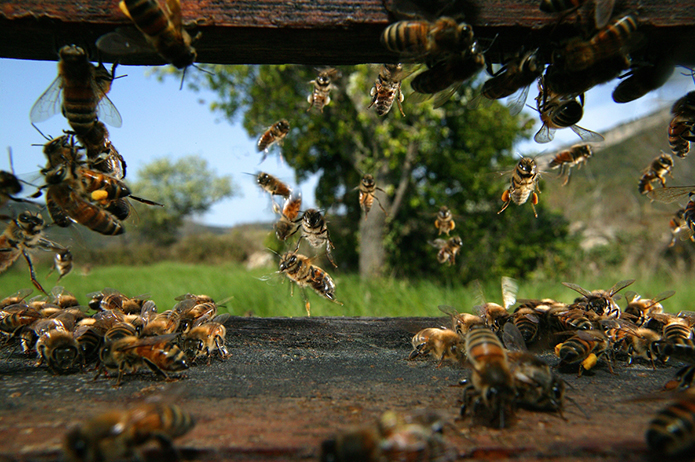
Image © Éric Tourneret / www.thehoneygatherers.com.
The humble honey bee is a familiarly comforting sight on a warm sunny spring day, when for the first time, in what seems like an age, there seems to be real warmth in the sun. The sun’s renewed heat has coaxed outside both you and the honey bee, and its presence seems to confirm, beyond the brave snow-drops, crocuses and daffodils of winter and early spring, that gave us initial hope (often dashed under a shroud of late spring snow) that summer and its inevitable warm lushness of greens and hot flashes of colour will indeed return, accompanied by the heady but gentle buzz of busy bees on a lazy summer’s afternoon.
This is an idyllic image of the shifting seasons; the fascinating unswerving work ethic of the bee’s micro-world, mini-kingdoms, ruled by an omnipotent queen, operating all over the planet – naturally occurring highly organised work-forces – which we, as wilful human beings, could never, and would never want to fully emulate, although we do, at times, harness their efficiency and manage their colonies in the form of hives, reaping the hallowed honey and beeswax – the miraculous end-products that these profoundly clever little creatures magically muster.
It would be all too easy to assume this natural cycle of perfected productivity – which as a by-process means that humankind’s cultivated crops, plants for foodstuffs and industry are vitally pollinated as the bees collect pollen and nectar for their micro-industry – will continue unchanged for time immemorial, however more recently this natural process has been interrupted. The honey bee is in danger of becoming extinct; a number of diseases, most notably the varroa mite (which decimates infant bees), are weakening colonies, as is mankind’s increasingly intensive monoculture model for agriculture.
If the bees are allowed to simply disappear, what will pollinate our crops? The continuation of our food supply depends on this humble little insect and we wanted to explore the fascinating world of the honey bee, and what can be done to turn this worrying trend around, and ensure a sustainable future, for both the bee and mankind. Man’s global relationship with the bee is a subject that Éric Tourneret, ‘The Bee Photographer’, is extremely well-versed upon, and he has kindly agreed to share his candid thoughts and stunning images with us in an attempt to highlight this pressing issue.
About Éric Tourneret
A photojournalist for over 25 years, Éric Tourneret’s skilful work has been visible within numerous high profile French magazines, such as Figaro and Paris Match. Since 2004, Eric has dedicated his career to discovering and displaying the types and traditions of beekeeping, honey hunting and honey gathering in different societies and subcultures, aided by the liberating flexibility of breakthroughs in digital photography.
Éric challenges the inevitability of the disappearance of such cultures and their techniques, as well as bees and beekeeping per se, by the ever-creeping crush of globalisation, instead encouraging a challenge to previously assumed priorities and value systems.
Éric’s resultant publications, Le Peuple des Abeilles (The People of the Bees, Rustica, 2007) and Cueilleurs de Miel (The Honey Gatherers, Rustica, 2009) contain fascinating insights complemented by exquisite images of bees and their keepers, and everything else in and around the hive. While large format photos from the books continue to be exhibited throughout the world in nature parks, libraries and museums of natural history, Éric has turned his fascination to television documentary as well as film.
His work has become an important photographic reference on the bee, and we hope you enjoy and are inspired by the interview:
Firstly, can you tell us a little about the honey bee used by beekeepers?
Beekeepers use the Apis mellifera honey bee. It’s particularly well adapted to very diverse biotopes, from cold Scandinavia to the hot Middle East. The Apis mellifera followed Europeans as they colonised throughout the world, and the species now lives in nearly all countries inhabited by humans.
Why are honey bees so important for the environment?
Honey bees are essential for pollination, so both natural ecosystems and agriculture are directly dependent on them for the sexual reproduction of all flowering plants. Without honey bees we wouldn’t have seeds, nuts, fruit or vegetables, and 30% of the world’s food production depends entirely on pollination. Without pollination cattle, sheep and other farm animals will also have problems with the lack and poorness of their food. Honey bees are part of the life cycle chain, and pretty much all of nature is dependent on them, directly or indirectly. There are some other insects that pollinate, such as the bumble bee, and even some birds in Mexico, but not anywhere to the same degree that honey bees do. Sure, it’s possible that some orchards could be pollinated by hand, as they do in some parts of China, but this is hugely labour intensive, and costly, and to think that the bees do it for free! Scientists at the French National Institute for Agronomic Research estimate that some 153 billion Euros per year is dependent on the contribution that honey bees make to the world, which is huge compared to the turnover of an international agro-chemical company like Monsanto which is only one billion Euros.
I’ve even heard it said that the without the honey bees, the human race would die out within a few years. I’m not sure if the entire human race would die out or not, but it would certainly be devastating and the cost in human lives would be enormous. It’s essential that we look after the honey bee, as they’re in serious decline. Colonies are dying out around the world and we need to take action.
Excuse my ignorance for a moment, but I always get confused between pollen and nectar, what do bees actually feed on?
Pollen is basically the sperm of the flower; it is food protein for the bees, needed for the brood, for the growth of the bee larvae. Pollen isn’t needed in winter, as the queen doesn’t make any eggs then. Bees search for pollen by flying around and foraging on flowers; they make balls of pollen and put it on their legs and bring it back to the hive.
Nectar is made by the flower to attract insects, to ensure cross pollination; when insects go from flower-to-flower, they cross pollinate the plants, to allow seeds to grow, for instance. Bees forage for nectar in the same way as they do for pollen. Nectar is glucose; it is food energy to allow the bee to fly around. They do this by turning it into honey. They obtain nectar and eat honey using a long proboscis, or tongue.
Bees need energy in the winter when it is cold to keep the hive warm at a constant 35C; they create heat by forming a cluster and vibrating their thoraxes. The queen, remains warm in the centre of the cluster. During the winter, bees rely on honey for energy to keep warm and for food, which they store in honeycomb, hexagon shaped wax cells made by the bees. That’s why beekeepers can’t take all the honey from the hive in the autumn, otherwise they would all starve.
Why are bees endangered?
Since the dawn of time, bee colonies have been confronted by predators. Hunters such as wasps and hornets, parasites such as mites, and, of course honey-lovers such as bears and humans who are looking to plunder the honey which the bees gather as food reserves for the flowerless winter, are all a threat to the bees, but up until now they have survived, mainly due to the diversity of the apis genus.
In short, they are dying of starvation. Intensive monoculture, where the same crops are grown across vast tracts of land, has resulted in lack of food for the bees to forage on. You might think there are luscious fields of green vegetation, but it’s the flowers that bees forage on, and intensive monoculture means that flowers are only around for a short part of the year, perhaps a month and a half, all at the same time, and the rest of the year there isn’t anything else for the bees to live on.
Green deserts without insects are appearing throughout the world, and it’s a massive problem and we are close to breakdown. A lot of press attention is focused on the Varroa mite, which has badly affected colonies, but intensive monoculture is the key problem. The exportation of our agricultural model around the world due to demographic pressure leading to deforestation and further intensive agriculture is going to mean the problems are going to become more widespread.
Before intensive monoculture, there was diversity of crops, which meant that bees could move around and feed on different flowers at different times of the year. There were also more hedgerow flowers, but huge amounts of hedgerows have been removed to ‘improve’ agricultural production.
This quest for increasingly ‘efficient’ agricultural production has necessitated an excessive and aggressive use of chemical fertilisers, herbicides and pesticides; subsequently wildflowers and other naturally-occurring plants which are vital to provide balance and harmony within our ecosystems are disappearing, which has a drastic effect upon the insect population as a whole, especially the honey bees, with colonies and man-managed hives dying out every year, which we now call Sudden Colony Collapse Disorder. Pesticides inside the plants act as a neuro-toxic, and the bee’s nervous system is destroyed, meaning it can’t find its way home. For more than 50 million years bees had a totally symbiotic relation with flowers, but it’s this interdependence that is also its weakness. As the bees are used to the flower’s purity, they haven’t been able to develop any resistance these toxic substances.
Studies have been carried out by scientists looking at wax and found that over 35 types of different herbicides and pesticides were found in it, so by default they would be in the honey as well, which is a nasty cocktail people shouldn’t have to eat. Thousands of tonnes of pesticides are unleashed on the land each year throughout Europe, and we, and the bees of course, are now starting to pay the price.
Without beekeeping by dedicated apiculturists, the domestic honey bee would have disappeared from industrialised countries decades ago, but for how much longer is another thing altogether.
What can we do to resolve this?
The Varroa mite is a problem; it’s a bloodsucker which feeds off young bees. It weakens the colonies and their resistance to viruses. A lot of work is being done on genetic selection to find bees that aren’t affected by the mite, and there are other solutions to lower the mite quantity within the hive, by moving the drone cells away from the hive, as it’s the drones that the mites are attracted to. There are also some types of chemicals which can kill the mite. When the mite first surfaced in the mid-1990s, it affected everyone badly, as no-one was prepared, but it’s manageable.
However, the biggest threat to the honey bee, intensive monoculture, also requires the biggest solution. I think we need to re-localise the rural economy. Local farming, organic farming, permaculture, community gardening, ‘Landshare’, citizen farming; all these practices would help. It can be done. Look at the UK before World War 2 – before the war the country was 50% dependent on imported food, and within two years the country was 95% self-sufficient. Huge emphasis was placed on turning over un-worked land through the ‘Dig For Victory’ campaign, and it is possible to revert to more environmentally-friendly and sustainable farming practices. Of course, the Government won’t like it, because it generates less tax income. But I think local farming is the way forward.
The author Paul Hawkin wrote an interesting book called ‘The Ecology of Commerce’ in which he describes how large corporates could and should help eradicate the problems in the world, and Rob Hopkins’s Transition Towns movement is also very enlightening and inspiring, looking at sustainable living and ecological resilience in local communities. I think these environment and social movements are the way forward in Western societies. This is particularly apt at the moment, when 15% of many parts of Europe are unemployed, and if the vacant land around our cities was made available to the unemployed, our towns and cities would be more self-sufficient in organic fruit and vegetables, and we could reduce the amount of ‘food miles’ and therefore pollution, and all of this would be beneficial to the bees, and not to mention more social benefits.
Of course, we also need to start reinstating hedgerows and woodlands around the edges of fields and roads, and we can all grow more flowers in our gardens.
What type of plants should we grow in our gardens, fields and paddocks to provide food for bees?
For people who have a garden, plant an interesting variety of flowers and, if possible, melliferous trees (i.e. those that can be harvested by the domestic honey bee), as some species are better than others for providing nectar and pollen. Berries such as blueberries and raspberries are good. Vegetables such as zucchini [courgettes] and carrots are also good due to their flowers. Plants such as wild thyme, rosemary, lavender, snowdrops and sunflowers are also ideal. Consider leaving areas for wildflowers and weeds to grow – bees like weeds such as thistles, dandelion, clover and even poppies.
If you have room, and can plants shrubs and trees, I’d suggest rhododendrons, rowan, almond, sweet chestnut, linden [lime], holly, honey tree [Tetradium danielli], willow and hazel as they’re all suitable for bees. For those that have more land, create embankments, hedges and stands of trees. If you have the opportunity, why not install a hive or two…
Use natural methods and products against parasites, instead of aggressive chemicals.
I’ve heard that urban beekeeping is becoming extremely popular and the number of hives in London has more than doubled in the Noughties. Do you think urban beekeeping is a positive thing, and do you think there is enough food to support the increased bee populations?
Urban beekeeping may well contribute to the salvation of the bees. Cities are comparatively pesticide-free compared to rural areas, and provide a variety of bloom from spring through to autumn, so there is plenty of food to forage on. The temperature is warmer in urban areas, by as much as 4 degrees more than the surrounding countryside, and this helps as well. An awareness of the decline in bees has prompted Parisians into action, and beekeeping suppliers have been recording record sales and there has been huge demand for beekeeping classes.
I’ve heard that in other cities, such as London, there are food shortages for bees, but the balance is fine in Paris. I think one of the problems in London might be lack of training. Some people have good intentions to start a hive, but they don’t really know what they’re doing. It can get quite technical, and it’s important to have training from a Master Beekeeper.
I’m a strong advocate of growing as many mixed plants and trees in urban areas as possible, whether this is in peoples’ gardens, on roof tops, or public spaces. It all helps feed bees. Bees especially like linden [lime] trees, and there are lots of these in Paris and Berlin. In Berlin there are normally 2,500 hives throughout the city, but in linden season, when they’re in bloom, this goes up to 15,000 hives and 600 million bees (!) as professional beekeepers bring thousands of hives to the city to produce excellent linden honey. Berlin is undoubtedly the greenest city, and whilst it’s noted for its linden trees, they also produce other sorts of honey such as maple, chestnut, acacia and honey tree. Beekeeping is very popular here, and there are fourteen different beekeepers associations and over 750 amateur beekeepers.
Can you give us any insights into how intelligent bees are and the collective way they work together?
Once a worker bee is old enough, and strong enough, she (as they’re all girl bees) will head off on foraging trips; which they all do individually. On her first flight, she will make a mental map of the area in order to find her way back home. She’ll forage on sugar-rich nectar and nutritious pollen-rich flowers as close to the hive as possible, preferring to travel within 500 metres, but she will go as far as 4 or 5km. Once a productive foraging area has been found, she come back to the hive and give this information to the other bees.
Bees communicate to each other through enthusiastic dances involving intricate, shimmying figure-of-eight patterns, and through rubbing antennae. They pass on information such as where the food source is, how worthwhile it is, what it tastes like, and they may even give out samples. Bees are very clever at balancing whether the quantity of energy to go to a particular spot is worthwhile for the amount of food brought back versus the quantity of energy to do a similar task in another [nearer] spot. Most of worker bees will go to the most productive foraging sources, but some will continue to explore elsewhere to see if there’s a better source, and this information will be shared. At any one time there are many thousands of foraging female workers in each colony, all working together for the same cause.
The collective way of life of bees is admirable for our own social models. A Breton beekeeper told me that if a colony found itself with a food shortage, all the food would be shared amongst all the members, up until the end. A beautiful example of solidarity!
Why have you dedicated your career to photograph bees?
I grew up in the countryside, on a mountainside above Annecy in France, and I was very close to nature when I was young. When I learned that the bees were vanishing, around the same time as the Gaucho [pesticide molecule] scare in France, I took the decision in 2004 to investigate what is happening and I have dedicated my professional life to it ever since.
I was shocked that the causes of the decline in bee population is a politically incorrect subject to talk about, and I think this silence consolidated my belief that it was a subject that needed investigating further.
In addition to photographing and researching bees, I also have been own hive in Normandy, and I carry a smoker with me in my car wherever I go, so when I am photographing bees with other beekeepers, I’m able to open up the hives myself and like to participate and help.
How far back does apiculture, or beekeeping, go in history and when were the first artificial hives used?
Bee hives were harvested in the wild before agriculture; cave paintings in Valencia, Spain, dated over 8,000 years ago, show honey-hunters collecting honey and honeycomb from a wild bee nest.
Honey bees were the first animal to be domesticated although it’s not known when the first beehives were used, but we’re pretty sure they were made from clay, as samples found in Mesopotamia dating from several thousand years ago. A definitive piece on the history of apiculture was written by the respected English author Eva Crane ‘The World History of Beekeeping and Honey Hunting.’ Everywhere around the world, the local population will use natural materials to make hives. Whatever they can find they will make them out of it i.e. clay, wood. The ones in Egypt and Mexico were made of clay, and could be re-used. In rest of Africa, they used baskets made from wood and straw, and these have been used in other countries too.
Honey was used in cakes and biscuits, and many other dishes to sweeten food. Honey was also used to make mead, an alcoholic drink used in celebrations made by simply adding water to honey and allowing natural fermentation to occur. Mead came before both beer and wine! Mead has been drunk in all cultures, and today is very popular within African and South American tribes.
The famous French anthropologist Claude Lévi-Strauss, in his work Du Miel aux Cendres [The From Honey to Ashes] noted that every tribe in South America had their own type of mead related to honey.
Is there a difference in taste of honey from plant-to-plant, bee species-to-bee species, and from the start of the season to the end of the season?
Honey is like a wine. Every type of honey will be different and it will never be the same. Different hues and flavours will depend on the type of bee, differences in pollen, type of flower and stage of season.
Some types of honey are called ‘mono-floral’, which means the honey comes from a particular nectar source from a particular plant species. However, even mono-floral honey will only be approximately 95% from the same flower, and the remainder is made up from nectar from other species, as bees will organise themselves so that not all food comes from one source, and they constantly search for different sources. It is the make-up of the remaining 5% that will make the difference in taste.
The different colours of the honey indicate the origin of the nectar, depending on whether it is sunflower, thyme, linden, pine, chestnut or heath.
How many bees are in a typical hive and how much honey would they make in a year?
A typical modern hive can have between 40,000 and 100,000 bees in a single hive during the height of the season, depending on the strength of the colony.
The amount of honey that a hive produces is really dependent on the food quantity and quality. For a plant or tree to give good nectar, all the conditions need to be right i.e. there has to be right wind, water, warmth etc, and it all needs to be in balance. Sometimes the absolute best conditions may only last a few hours.
In Berlin, due to the greenery and temperature, an average each hive produces a staggering 30 kilos of honey each year, but that’s just an average and some hives can produce a lot more than that. Some hives in Paris have been known to produce up to 100 kilos per year each, compared to 10 – 20 kilos for those in rural areas, but it depends on having the right flowers and a strong, well-managed, colony.
A friend of mine had 80 hives in the south of France set amongst rosemary flowers, and in a 3 week period, his hives produced over 3.5 tonnes of honey! Another year he only produced 350 kg!
Aside from producing honey, and pollinating crops, do honey bees provide any other benefits to humans?
There are a number of benefits from beekeeping, not just from the honey and pollination of crops, although these are probably the most well known.
Apart from the lovely taste of honey on bread, it does actually have medicinal properties, and is often used as a medicine to cure wounds and colds. Apart from its moisturising and nourishing cosmetic creams, it also helps against infections, promotes tissue regeneration and reduces scarring; natural thyme honey bandages have been used at Limoges University Hospital since the late ‘80s to help wounds heal more quickly.
Beeswax, from the honeycomb cells that bees make, has a number of uses, not just in making candles. The ancient Egyptians used it in making mummies, it has been used for metal castings, and it has long been found in medicinal creams and lotions. Today, about a third of beeswax produced is used for cosmetics, a third in pharmaceutical uses, a fifth for candles and the remainder a variety of other uses, such as textile manufacturing, wood polish, and food processing, packaging and preservation; the glossy sheen on supermarket apples and jelly beans comes from beeswax!
Pollen, which comes from the spherical grains contained in the pollen sacs of flower anthers, is gathered by the bees and packed into two pollen pellets on their hind legs to feed to honey bee larvae. It has great nutritional value, and some beekeepers harvest it by having bees pass through a grid. The pollen is then used in medicine, cosmetics and food; some high performance athletes are said to be using pollen in their diet.
Propolis, a very sticky mixture of beeswax and resins from plants which bees use to seal the hive and combs, has excellent antibacterial and antifungal properties, and is used in cosmetics and a wide range of medicinal uses, such as treating anaemia, fighting infections, tissue regeneration and many other uses. Propolis is quite odorous and is responsible for the smell of wax. It has apparently been used in special varnishes, such as those used by Stradivarius for his violins.
Royal jelly is a secretion mixed with pre-digested pollen produced by the pharyngeal glands of the young nursing bees. It is an exceptional nutrient, essential for the development of a colony, allowing bee larvae to grow at a pace with no equivalent in the rest of the animal kingdom. Royal jelly is the exclusive honey bee queen larvae food. The spectacular fertility and long life-span of the queen has led people to think that royal jelly could have similar beneficial properties for humans, although these claims haven’t been scientifically proven. In any case royal jelly is sold as dietary supplements, and as a source of vitamins; most of the time this is sold as fresh royal jelly by beekeepers, but it is also available in tablet form, usually from Chinese beekeepers. Royal jelly is also used in cosmetics for skin care and natural beauty products.
The venom from bees is also supposed to have medicinal benefits due to its anti-inflammatory effects, and is used in the treatment of arthritis, rheumatism, and even multiple sclerosis. By extracting the bee from the hive using a tube, the bee is isolated and then specific points on the body are stung with the bee’s stinger (a process known as api-acupuncture), although the venom can be extracted and applied to the patient using ointments, inhalations and tablets.
Given the difficulties associated with beekeeping at the moment, what do you see as the future for beekeeping?
This is a very political question, but it’s an important one and is linked to the future of humanity. I think Governments, lobbyists and major agricultural corporations should together shoulder the blame for the decline in the bee populations around the world. If we don’t care about the environment, then it’s the end of beekeeping.
My solution would be to ban lobbying and change the law to make companies responsible for their pollution; ensure there is personal legal responsibility so that the people that own and run the major corporations are responsible for the molecules that end up in the food chain. If we return towards a local farming economy, stimulate the reintegration of the nature in town, we can successfully transition ourselves towards a more human society.
Everyone can also contribute by buying honey from local beekeepers. Without demand for local honey, beekeepers couldn’t invest their time managing colonies.
At some point people have to realise things cannot continue as they are. The Native American Cree Prophecy is very apt to beekeeping:
‘When all the trees have been cut down, when all the animals have been hunted, when all the waters are polluted, when all the air is unsafe to breathe, only then will you discover you cannot eat money.’
I am hopeful we can find a way.
Finally, if I wanted to escape the rat race, and become a beekeeper, how much land would I need and what would I need to do?
There are 55,000 beekeepers in France, of which most have only 10-20 hives each, which brings in some extra money, but not enough to live on. However, a 20 hectare apiary could sustain 120 hives, and if you planted the right bee-friendly plants and trees, and with the right training, I imagine you could make a good living!

